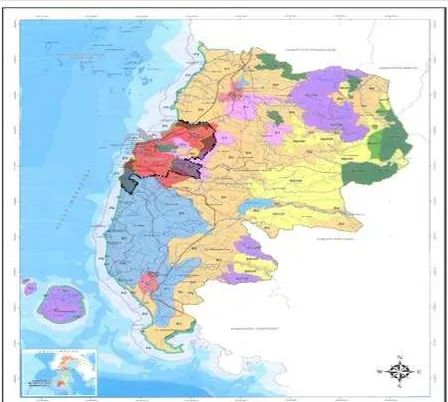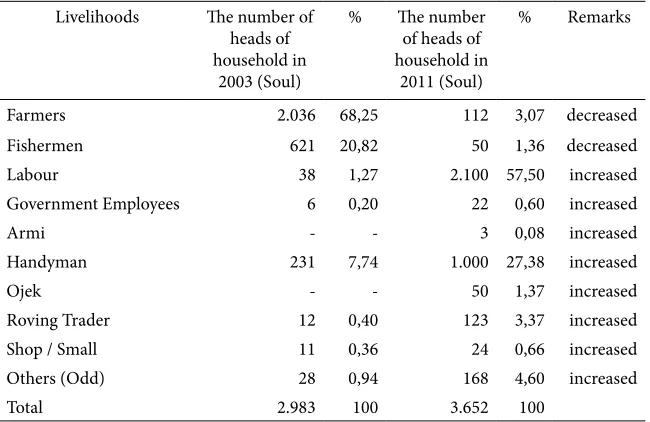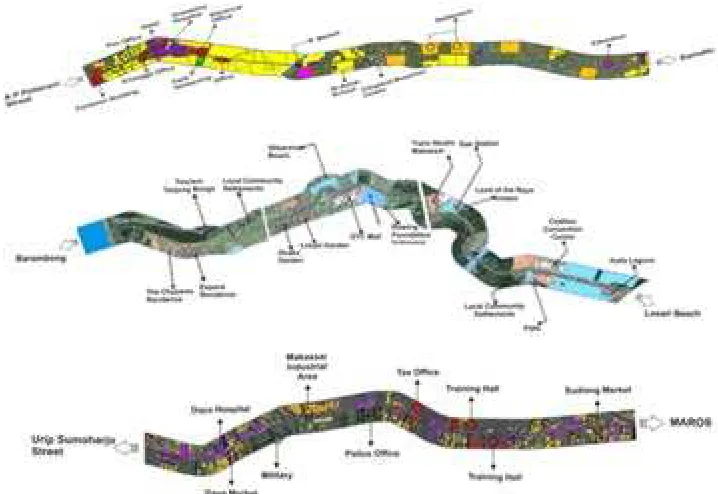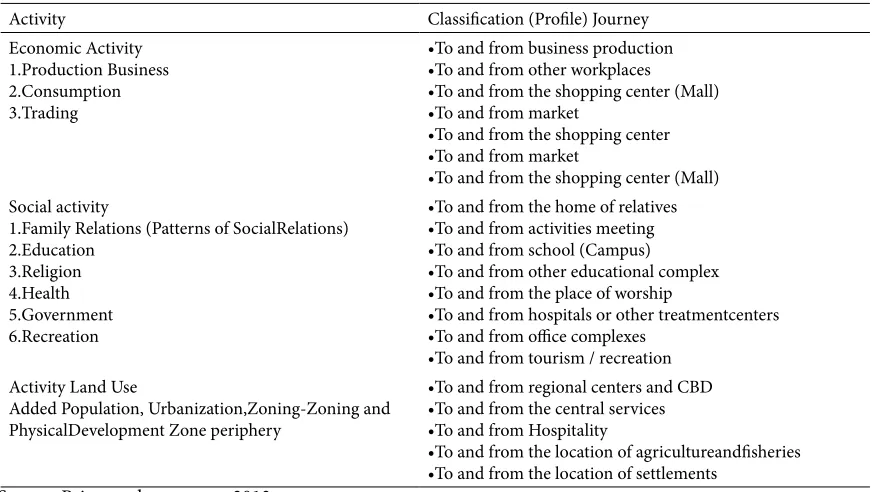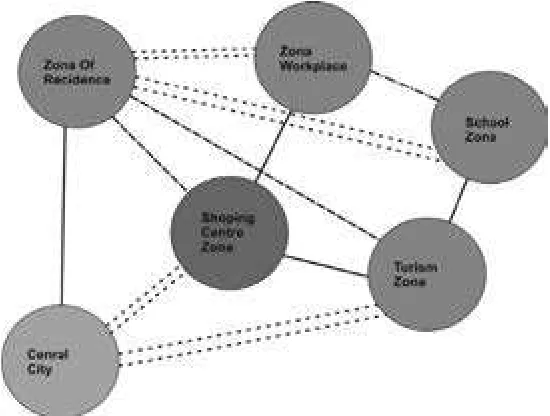IJG Vol. 47, No.1, June 2015 (11 - 19) © 2015 Faculty of Geography UGM and he Indonesian Geographers Association
he Dynamics of Spatial Structure and Spatial Pattern Changes at
the Fringe Area of Makassar City
Batara Surya
Received: 30 01 2015 / Accepted: 02 02 2015 / Published online: 30 06 2015 © 2015 Faculty of Geography UGM and he Indonesian Geographers Association
Abstract he study is conducted at the fringe area of Makassar City by analyzing dynamics of spatial structure and spa-tial pattern changes at the fringe area of Makassar City. It applies quantitative and qualitative approaches (mixed meth-od). Data is acquired from some sources and informants living at the fringe area of Makassar City. Spatial utilization shit and development of transport infrastructure, especially for main road corridor connecting down town of Makassar City and fringe area, afect signiicantly spatial structure and spatial pattern changes at the fringe area of Makassar City. Dynamics of spatial structure and spatial pattern changes contributes changes of resident mobility; while, development tendency of the existing spatial and land use is no longer determined based on productivity, but it is valued by functions of space and land at the fringe are of Makassar City.
Abstrak Penelitian ini dilakukan pada kawasan pinggiran Kota Makassar dengan menganalisis dinamika perubahan struktur ruang dan pola ruang kawasan pinggiran Kota Makassar, menggunakan pendekatan kuantitatif dan kualitatif (mixed method). Data diperoleh dari beberapa sumber dan informan yang mendiami kawasan pinggiran Kota Makassar. Pergeseran pemanfaatan ruang dan perkembangan prasarana transportasi khususnya pada koridor jalan utama yang menghubungkan pusat Kota Makassar terhadap kawasan pinggiran, berpengaruh secara signiikan terhadap perubahan struktur ruang dan pola ruang kawasan pinggiran Kota Makasar. Dinamika perubahan struktur ruang dan pola ruang berkonstribusi terhadap perubahan mobilitas pergerakan penduduk, dan kecenderungan perkembangan pemanfaatan ru-ang dan lahan yru-ang ada tidak lagi dinilai berdasarkan produktivitasnya akan tetapi dinilai berdasarnya fungsinya pada kawasan pinggiran Kota Makassar.
Keywords: Changes in Land Use, Changes in Structure of Space, And Pattern Change Space, Fringe Area
Kata kunci: Perubahan Pemanfaatan Ruang, Perubahan Struktur Ruang, Dan Perubahan Pola Ruang, Kawasan Pinggiran.
Activity function shit at the down town of Makassar City is identiied as the consequence of modernization and globalization factors, while by the time urbanization occurs, it directly causes land use conversion which occurs intensively enough at the fringe area of Makassar City. his condition is marked by expansion of strategic economic activities and other social functions. It implies to the occurrence of continuous transformation process at the fringe area, and also it makes spatial physical appearance of this area change. Other implication is suburbanization which occurs fairly signiicant at the fringe area of Makassar City. Observable direct impact is spatial function shit and morphological changes at the fringe area of Makassar Area.
In general, to understand development process of Makassar City, there are two principles: First, Makassar City is designated as the development center for
Batara Surya
Urban Regional Planing University of “45” Makassar, Indonesia Email: [email protected]
Eastern Indonesia Zone (KTI) and at the same time, it also becomes national and regional activity center concerned with its position as the provincial capital of South Sulawesi Second, reposition of Makassar as global city refers to a fact where rapid growth rate isshown by urban economic activity centers and urbanization world wide heading to modernization of a city; accordingly, it indicates that modernization of city has also happened in Makassar. In the growth process of Makassar, it is not only afected by activities taking place there in, but it is also afected by external factors. Regarding development of Makassar City in which the city becomes activity center at national and regional scale, it will inally create intercity linkage pattern. Aterwards, this linkage willform planological concentration and urban services center system in Mamminasata Metropolitan.
and innovation via urban transport infrastructure network. hese lows and networks, then, build a linkage of intercity economic system in Mamminasata Metropolitan. Further process repositions Makassar City as a core city and accumulation center for strategic socio economic activity at national and regional scale.
Revolutionary spatial physical changes through spatial functions shit at the fringe area of Makassar City are not only driven by urbanization factor, but it also relates to shit of means of production toward reproduction of and production of space in representational manner. Consequently, it changes Makassar face into modern city. his reality is relevant to theoretical conceptualization of Lefebvre (in Ritzer, 2008) that representation of elite space dominates spatial practice and representational space. It means that production of space, which is representational performed by elites, triggers dynamics of spatial structure and spatial pattern changes at the fringe area of Makassar City.
Considering on the process, it is assumed that dynamics of spatial structure and spatial pattern changes at the fringe area of Makassar City has two afecting factors, i.e.(a) spatial development process in centrifugal manner and (b) spatial development in centripetal manner. he reality conforms to theoretical conceptualization of Yunus [2008] stating that spatial development process horizontally becomes determination of urban area expansion and building density at the urban fringe area. hus, spatial function shit of Makassar City center heading to fringe area is a sort of spatial expansion process which occurs horizontally by occupying empty spaces. his process, then, is justiied as accelerator for spatial structure and spatial pattern changes at the fringe area of Makassar City. Spatial function shit heading to the fringe area of Makassar City is marked by land use conversion and development of new activity functions, for example functions of residential area, trade, industry, tourism, education, health, oice, services and other commercial functions [Soetomo, S. 2009].
Early condition before development at the fringe area of Makassar City was present, economic value of the land was low. Ater construction was carried out by the developer, the land is not only utilized to build shopping center (Mall and shopping complex), but also to build elite residential area along with adequate, complete and modern means and infrastructure. More over, developer also prepares Mature Land Plot (Kaveling Tanah Matang or KTI); consequently, the fringe area of Makassar City transforms into new location for residential area and new economic center. he reality is in line with theoretical conceptualization developed by Yunus [2008] that there aresix factors afecting urban fringe area development, they area: First, accessibility factor. Physical accessibility changes at the fringe area of Makassar City are shown by development of transport infrastructure which makes connection
and accessibility therein increase. Second, factor of public services; this attractive factor stimulates resident mobility and replaces urban functions at the fringe area of Makassar City.hird, characteristics of land; it takes the role as stimulating factor afecting the height of new functions development and expansion. Fourth, characteristics of land property; in principal, it refers to spatial development pattern at a place regarding on development intensity and acceleration. Fith, presence of regulation regulating spatial zoning plan; it is one of factors afecting spatial physical changes intensity at the fringe area of Makassar City, and sixth, factor of developer initiative; it has very signiicant inluence in directing spatial physical development at the fringe area of Makassar Area. hese six factors are justiied as the determining factor in dynamics of spatial structure and spatial pattern changes, function of agglomeration and dis agglomeration at the fringe area of Makassar City.
2. he Methods
Research site is in the fringe area of Makassar City (Figure 1). It is carried out on November, 2011 to August, 2013. Applied approach is case study. Case study characteristics aim at understanding background or phenomenon as the consequence of dynamics of spatial structure and spatial pattern changes at the fringe area of Makassar City.
Applied data analysis method is quantitative-qualitative method (mixing methods) from Denzin and Lincoln [2009]. Philosophical reason in combining these two approaches are: (1) triangulation logic; in this matter, qualitative research inding is rechecked by quantitative research, and vice versa in order to strengthen the indings validity, (2) quantitative and qualitative research are combined to give a general over view, (3) quantitative research is applied to structural characteristics of social life, and qualitative research takes subject’s quality as starting point, so these two approaches are attended collectively to execute the study, (4) quantitative research is applied in analyzing relationship of inter-alterations, qualitative research is applied to assist in harmonizing factors underlying constructed relationship, (5) quantitative approach is applied to reveal structural characteristics of social life in large-scale size, while qualitative approach tends to reach behavioral in small-scale size, so researcher makes an efort to reveal these two levels, so quantitative and qualitative guides are applied collectively, and (6) in order to obtain data of the two diferent realities, it needs combination of the two approaches (quantitative and qualitative).
3. Result and Discussion
over surrounding cities like Sungguminasa, Takalar and Maros Cities. his designation, then, afects accelerated growth at the fringe area of Makassar City. It afects signiicantly urban spatial utilization shit at Mamminasata Metropolitan.
Spatial utilization shit at the fringe area of Makassar City is marked by intensive land use conversion, thus it changes morphological appearance at this area. he indings show that spatial utilization shit at Makassar City is proved by presence of dominant new functions, for example functions of industry, education, trade, transport services and residential function. Growth of functions at the fringe area of Makassar City indicates that land use conversion, based on its intensity, is highly determined by new residential functions at a large scale. Accordingly, residential function has a very signiicant inluence on the land use conversion, and it associates positively to urbanization process happened over time. Dominantly, migrants live at this fringe areaas the place to live.
Process of spatial utilization shit at the fringe area of Makassar City afects resident orientation change on
activity and their operated business. During year period from 2000–2002 and 2003–2011, growth at the fringe area of Makassar City is marked by rapid accelerated growth, and of course, it is shadowed by population growth. Existing land use conversion directly afects spatial pattern changes and it reduces size of agricultural land and rearing pond. It is shown by the height of land sales and purchases. Consequently, since two-year periods, agricultural and isheries business are no longer became dominant business as main livelihood of the residents. his phenomenon implies that resident orientation on livelihood changes a lot and it depends on spatial physical change and spatial function shit at the fringe area of Makassar City.
Table 1. Resident Orientation Change on Livelihood in 2003-2011
Livelihoods he number of heads of household in
2003 (Soul)
% he number of heads of household in
2011 (Soul)
% Remarks
Farmers 2.036 68,25 112 3,07 decreased
Fishermen 621 20,82 50 1,36 decreased
Labour 38 1,27 2.100 57,50 increased
Government Employees 6 0,20 22 0,60 increased
Armi - - 3 0,08 increased
Handyman 231 7,74 1.000 27,38 increased
Ojek - - 50 1,37 increased
Roving Trader 12 0,40 123 3,37 increased
Shop / Small 11 0,36 24 0,66 increased
Others (Odd) 28 0,94 168 4,60 increased
Total 2.983 100 3.652 100
Table 2. Resident Business at the Urban Fringe Area of Makassar City in 2003-2011
Business Sector Business Sector 2003%
% Business Sector 2011%
% Remarks
Agriculture 96 14,79 36 2,88 decreased
Industry - - 10 0,80 increased
Building Con-struction
137 21,11 143 11,42 increased
Trade 406 62,56 977 78,04 increased
Transportation 10 1,54 86 6,87 increased
Total 649 100 1.252 100
commercial business).
he table 2 portrays phenomenon in 2003 where 14.79% of residents work inagricultural sector and in the end of 2011, 2.88% of working age residents at the fringe area of Makassar City work in agricultural sector. When it was 2003, industrial activities have not been carried out a lot, but in the end of 2011, job vacancy in this business in creases by 0.8%. In 2011, 11.42% of working age residents works at building construction. he largest percentage of business sector in the end of 2011 is achieved by trade sector. It reaches 78.04% and dominantly, trading businesses are carried out by migrants where trading location is means of commerce is built by developer. he meaning there of, from the time when rapid spatial physical changes at the fringe area of Makassar City take place, most of residents change their jobs into construction worker, small food stall, green vegetable peddler, villa and lodging rentals, and Mall employee, stafs of tourist resort or recreation, or handyman. A small portion of residents are working in transport sector (driver of a public transport or an ojék/hired motorcycle). It is just a small quantity of residents who make their life dependent on
agricultural business and home industry compared to other sector. hose who keep working in this sector are agricultural land owners where the land they possessed is relative narrow. Some other residents utilize empty land or other farm land which has not been utilized by developer for construction.
illustrates diferent resident’s economic capacity to meet residential needs [Forbes, K.D. 1983].
In another aspect, spatial utilization shit at the fringe area of Makassar City will inallycause complex spatial expression. Prominent spatial expression is observable in mainservice centers at the fringe area of Makassar City [Nas, P. J.M. 2005].
Spatial utilization shit at the fringe area of Makassar City, based on the indings, indicates that presence of new developed functions contributes positively to formation of new social structure there in. Accordingly, social structure changes are not only afecting social formation changes, but they are also creating social stratum, social status, and social classes. hey also streng then capitalism in dominating reproduction of space at the fringe area of Makassar City. here fore, it can be concluded that orientation change on resident livelihood at this area is afected by three main factors: (1) social system development in society is in unrepeated system condition, (2) further condition of the system relects a higher level; in this case, there is structure diferentiation in crease, i.e. economic output rise, economic advancement and population growth, and (3) development which is triggered by tendency in the system; in this matter, population growth associates with population density and internal contradiction by formulating new life at the fringe area of Makassar City.
Important point in spatial analysis developed by Levebvre (1972/1971) states thatspatial practice will shit from means of production to reproduction of space, so it makes spatial structure and spatial pattern change. Accordingly, phenomenon found in this proceeding process at the fringe area of Makassar City associates positively with spatial function shit from means of production to reproduction of space. In many
cases, space is reproduced by capitalist system, so it creates class structure in economic system. Conclusion may be made that spatial function shit at the fringe area of Makassar City has signiicant inluence on production of space in representational manner and social structure changes in the society heading to the more complex social structure.
Development dynamics at the fringe area of Makassar City, based on the indings, indicate that intensive land use conversion associates positively with formation of new spatial structure at this area. Formed spatial structure at fringe area contributes to social structure changes in the society because it is bridged by presence of new functions and transportation system changes at the fringe area of Makassar City. Centrifugal spatial physical development which occurs length wise expands region of Makassar City, so it enlarges urban area. Accordingly, to the length wise direction where development is given will become constructed area (Figure 2). his length wise track is the road corridor going to the direction of Gowa Regency, Takalar Regency and Maros Regency. he track has controlled either residential area or non-residential area growth in suchway in purpose to make concentration of building construction lengthen in spatial distribution in stead of making it widen.
Concentric centrifugal spatial development at the fringe area of Makassar City is not iceable in aspect of urban area development form through out developed marginal area which had been cohesively uniied. his condition takes place speciically at the central fringe area of Makassar City through an accumulation of activity. Center point of it is marked by the presence of shopping centers, and then followed by development of various other activities and supported by presence of
residential area; those activities are cohesively uniied. his process illustrates that the efort to control spatial physical form at the fringe area of Makassar City is much easier because outer land of the developed area is empty land, while minimal obstruction to reach this place allows the government to build urban open green space. hrough out main road corridor from down town of Makassar City to the urban fringe has had various activities, for example: services, shopping complex, industry, high education, oice complex, residential area and recreation (Figure 3).
Determinant of new spatial structure formation at the fringe area of Makassar City is dominantly afected by presence of main road corridor. It functions either to connect the fringe area and down town of Makassar or functions and changes travel pattern of residents in the fringe area from origin of place and to destination of movement. he main road corridors are (a) Metro Tanjung Bunga connecting Makassar City and Gowa Regency and Takalar Regency, (b) Urip Sumoharjo– Perintis Kemerdekaan connecting Makassar City and Maros Regency, and (c) Hertasning–Samata connecting Makassar City and Gowa Regency. In conformity with the fact found that these three main road corridors contribute positively to formation of service centers,
and it afects signiicantly formation of spatial structure at the fringe area of Makassar City in addition to its contribution to the changes of resident mobility.
Table 3, spatial structure and spatial pattern changes at the fringe area of Makassar City in crease movement low of resident and diferentiate kinds of mode of transport tutilized by residents. Mode of transport used by inter resident also indicates signiicant diference. Use of transport mode types is highly determined by orientation of residentactivity. Utilized kinds of transport mode are motor cycle to support resident’s business,for example hired motorcycle driver, green vegetable peddler, and construction worker. Bike is also used to work and sell goods from door to door. Movement to outside of this area is commonly carried out by public transportation.
Based on kinds of mode of transport utilized by most of migrants is private vehicle. hus, it can be concluded that mode of transport used by inter resident to support their daily life indicates disparity between properties and vehicle ownership. hus, means of production shit into reproduction of space indicating dynamics of spatial structure and spatial pattern changes at the fringe area of Makassar City shows movement diferences in aspects of intensity, type of movement or
Figure 3. Concentric Spatial Physical Development at the Urban Fringe Area of Makassar City
Table 3. Comparison between Spatial Structure and Spatial Pattern Characteristics at Fringe Area of Makas-sar City, year period of 2000-2013
Description Characteristics Change
Physical Spatial Lama (1994-2000) New Spatial Physical (2003-2013) Pattern Space Dominated by agricultural land use
and farming Characterized by rural agricultural
Based on the functions(commercial, tourist,ser-vice,oice, and residential.
Structure Space Production activities directlyrelated to the local community residential facilities and traditional market activity
Characterized by thecomplexity of urban Linkage space transportation infrastructure is supported withequipment and facilities ade-quate support
Characteristics of Residential Community
utilized mode of transport. his phenomenon airms wealth gap between resident in and out of the fringe area of Makassar City [Surya, B. 2010].
Table 4, kinds of resident activity have an efect on space partitioning at the fringe area of Makassar City based on the existing spatial function. Based on grouping and categorization to the existing activities, changes of transport characteristics are directly afected by the following activities: trade/commercial, tourism/ recreation, and oice. hus, it can be concluded that changes of transport characteristics at the fringe area of Makassar City associate positively with primary functions of the area as an important part as the consequence of spatial structure and spatial pattern changes at this area.
Land use pattern which is divided based on spatial function will form travel proile, travel type and travel classiication. his travel proile will depict changes of transport characteristics at the fringe area of Makassar City. It is not only afected by resident travel internally,
but also afected by external factor from transport movement at the down town of Makassar City. Presence of main road corridor connecting the fringe area and down town becomes determinant of spatial utilization changes and transport characteristics changes at the fringe area of Makassar City. On the basis of observed travel pattern classiication, the very high movement intensity is caused by origin of place and destination of movement from and to oice complex, center of education and tourist resort or recreation area. (Table 5).
Based on the discussion above, it can be concluded that the emergence of new functions at the fringe area of Makassar City is starter of travel pattern changes performed by the residents. his travel pattern will always associate with changes of accessibility degree. One of factors supporting changes of accessibility degree at the fringe area of Makassar City is availability of the existing road network infrastructure. Diference of accessibility degree from residential area existing at Table 4.Travel Patterns Matrix of Residents based on the Use of Mode of Transport at the
Fringe Area of Makassar City
Type Moda Category Population
Local % New comers % Total %
Private Car 5 1,87 214 53,23 219 32,74
Public Transport 56 20,97 83 20,65 139 20,78
Motorcycles 80 29,96 101 25,12 181 27,06
Bicycles 68 25,47 0 0,00 68 10,16
Walking 58 21,72 4 1,00 62 9,27
Total 267 100,00 402 100,00 669 100,00
Table 5.Travel Pattern of Residents based on Activity Zone at the Fringe Area of Makassar City
Activity Classiication (Proile) Journey
Economic Activity 1.Production Business 2.Consumption 3.Trading
•To and from business production •To and from other workplaces
•To and from the shopping center (Mall) •To and from market
•To and from the shopping center •To and from market
•To and from the shopping center (Mall)
Social activity
1.Family Relations (Patterns of SocialRelations) 2.Education
3.Religion 4.Health 5.Government 6.Recreation
•To and from the home of relatives •To and from activities meeting •To and from school (Campus)
•To and from other educational complex •To and from the place of worship
•To and from hospitals or other treatmentcenters •To and from oice complexes
•To and from tourism / recreation
Activity Land Use
Added Population, Urbanization,Zoning-Zoning and PhysicalDevelopment Zone periphery
•To and from regional centers and CBD •To and from the central services •To and from Hospitality
•To and from the location of agricultureandisheries •To and from the location of settlements
Figure 4. Diferent Inter-zone Travel Pattern at Fringe Area of Makassar City
Information:
a. = Very high travel volume
b. = High travel volume
c. = Intermediate travel volume
d. = Low travel volume
the fringe area of Makassar City considers variables of time, cost, and choice of utilized mode of transport to service centers. By taking the valuated variables into consideration, it can be concluded that movement pattern from elite residential area to the existing service centers has high accessibility degree, if it is compared to residential area in habited by local residents. Diference of this accessibility degree will directly make diferences based on the utilized transport means and infrastructure services.Concept of urban development developed by Bunge (in Yunus: 2008) on development pattern at residential area shows indication of inter-zones exist therein. Bunge divides space into three spatial zones, they area (1) innermost zone (the city of death), (2) zone of transition between (1) and (2) (the city of need), and outer most zone (the city of superluity).
Based on the Figure 4, it explains that the in nermost zone is in habited by low in comeresidents for which it is marked by fewer social services. Residents living in this zone are exploited in such way by residents of other zone in form of “work exploitation”. Zone of transition between zone 1 and 3 is part of the city inhabited by working class. Life of the residents here in is better than zone 1, but it is less than the outermost zone. he outermost zone is in habited by elite class having power, great professionalism; they are come from reliable business men to reliable politician. Residence of this class is classiied as wonderful to “luxurious”. If this approach is adapted to spatial context in macro
perspective, it is relevant to beapplied. How ever, if it is adapted to micro-scale in urban area, speciically to the fringe area of Makassar City, it is conversely proportional to the reality.
hree spatial zones had been formed in development process of the fringe area of Makassar. he irst cone known as main zone is inhabited by high socio economic class which associates with high income. his zone is shown by fully equipped social services, and it is close by activity centers (shopping center). Dominant residents living here inare migrants consisting of ruling elite group, highly professional, “business men”. Zone of transition between zone 1 and 3 is location inhabited by working class; they aremigrants who come and live amongst native people. hese residents consist of employee working in commercial economic activity and industry whose income is muchbetter than residents of zone 3. he outermost zone (zone 3) is in habited by local residents with low socioe conomic stratum. Residence of this class is, commonly, in formof raised platform and very plain, and it tends to seem like slum residential area.
pattern changes at the fringe area of Makassar City has indication of domination over the existing land either to be used or to be utilized as the consequence of capital power. he refore, it can be concluded that land tenure occurredrecently is highly determined by individual fund ability and institution as the consequence of increasing land rental variance. It implies that the closer place by service centers, value of land is higher, and conversely.
Production of space at the urban fringe of Makassar City, basically, repositions role of land economic value which is no longer based on land potential as means of production, but reproduction of space. Reality found in the ield indicates that spatial structure and spatial pattern changes at the fringe area of Makassar City has signiicant inluence on land use value and land sales value/exchange rate. Use value is value of commodity in process of economy, while sales-value is value of commodity if it is sold. Based on development tendency of land use, inluence of this process is that land use is no longervalued on productivity, but function of the land.
4.Conclusion
Spatial utilization shit promotes intensive land use conversion. his phenomenon expands to morphological changes at the fringe area, causes complex spatial expression and makes framework of dominance over reproduction of space happen. his process will inally divide space at the fringe area of Makassar City into functions, although initial land use at this area was dominated by productive agricultural land.
Dynamics of spatial structure changes contribute to social structure changes. Social structure changes in the society indicate diferences in livelihood orientation, social stratum, social status, and social class as the consequence of new spatial functions. he existing spatial function changes, then, expand to transport characteristics changes at the fringe area of Makassar City.
Dynamics of spatial pattern changes at the fringe area of Makassar City afect formation of spatial utilization zones. his production of space afects signiicantly land and space use value where tendency to utilize the space or land is no longer based on productivity, but the function.
Denzin and Lincoln (2009), Hand Book Of Qualitative Research. Penerbit. Pustaka Pelajar Evers, Hans-Dieter. 1974. Social Structure of Southeast Asian Cities: Case of Padang. Prisma Publisher.
Forbes, K.D. (1983), Geograi Keterbelakang (terjemahan oleh: A. Setiawan Abadi.Judul Asli: Geograhy of under-development). Penerbit LP3ES. Harvey, D. (2009), Neoliberalisme Dan Restorasi Kelas
Kapitalis. Penerbit. Resist Book.
Nas, P. J.M. (2005), Kota-Kota Indonesia (terjemahan oleh : Nin Bakdi Soemanto). Penerbit. Gajah Mada University Press.
Ritzer, G. (2008). Teori Sosiologi: Dari Teori Sosiologi Klasik Sampai Perkembangan Mutakhir Teori
Sosiologi Postmodern (terjemahan oleh: Nurhadi. Judul asli: Sociological heory) Penerbit. Kreasi Wacana Yogyakarta.
Soetomo, S. (2009), Urbanisasi Dan Morfologi: Proses Perkembangan Peradaban dan Wajah Ruang Fisiknya. Penerbit. Graha Ilmu Yogyakarta.
Surya, B. (2010), Perubahan Sosial Pada Komunitas Lokal Kawasan Metro Tanjung Bunga Makassar, Laporan Hasil Penelitian Disertasi, Tidak Terpublikasi. Pasca Sarjana UNM.
Yunus, S.H. (2008), Dinamika Wilayah Peri-Urban Diterminan Masa Depan Kota. Penerbit. Pustaka Pelajar
